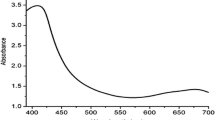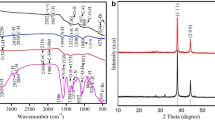Abstract
This study highlights the anti-oxidant and anti-cancer activities of bio-functionalized Thymus vulgaris silver nanoparticles (TVAgNPs) and bioactive compounds were compared using the human breast cancer T47D cell line. The aqueous ethanolic extract of T. vulgaris evaluated for chemical composition using the gas chromatography–mass spectrometer (GC–MS) analysis. The prepared TVAgNPs were determined by means of UV–Vis spectroscopy, FTIR spectroscopy, zeta potential, scanning electron microscopy, transmission electron microscopy, and energy-dispersed spectroscopy analysis. The T. vulgaris extract and TVAgNPs were studied for their in vitro anti-oxidant property by 2, 2-diphenyl, 1-picryl hydrazyl (DPPH) assay. Microscopic observations indicated spherical shaped and monodispersed nanoparticles and the average size of the nanoparticles was about 30 nm. Regarding the elemental composition profile of the TVAgNPs, the highest signal of silver (89.30%) was detected followed by other elements. An absorption peak was registered at 440 nm according to surface plasmon resonance (SPR) of the TVAgNPs in solution. A zeta potential of fabricated nanoparticles was approximately − 12.6 mV, indicating higher stability of the bio-functionalized TVAgNPs. The T. vulgaris extract and synthesized TVAgNPs were evaluated for their anti-cancer activity using 3-(4,5-dimethylthiazol-2-yl)-2,5-diphenyl-tetrazolium bromide (MTT) assay and Annexin V double staining with propidium iodide (PI) flow cytometric analysis toward T47D cells. The cytotoxicity properties of the bio-functionalized T. vulgaris AgNPs revealed that the sensitivity of T47D human breast cancer cells is high compared with T. vulgaris extract. The Annexin V/PI staining indicated that the fabricated TVAgNPs shows increased apoptosis in T47D cells as compared to untreated cells. Besides, the anti-oxidant activity of the TVAgNPs clarified a higher anti-radical-scavenging activity compared to Thymus vulgaris extract. Our data show that the potential biological activities of the bioactive constituents of T. vulgaris can be enhanced through bio-functionalized T. vulgaris AgNPs due to the bioorganic compounds that exist in the extract.











Similar content being viewed by others
References
Adersh A, Ghosh S, More P, Chopade BA, Gandhi MN, Kulkarni AR (2015) Surface defect rich ZnO quantum dots as antioxidant inhibiting α-amylase and α-glucosidase: a potential anti-diabetic nanomedicine. J Mater Chem B. 3:4597–4606
Agili FA (2014) Chemical composition, antioxidant and antitumor activity of Thymus vulgaris L. essential oil. Middle-East J Sci Res 21:1670–1676
Ahire M, Pardesi K, Bellare J, Dhavale DD, Jabgunde A, Balu A (2012) Synthesis of silver nanoparticles using Dioscorea bulbifera tuber extract and evaluation of its synergistic potential in combination with antimicrobial agents. Int J Nanomed 7:483–496
Ahmad A, Sakr WA, Rahman KM (2010) Anticancer properties of indole compounds: mechanism of apoptosis induction and role in chemotherapy. Curr Drug Targets 11:652–666
Ahmed KBA, Mahapatra SK, Raja MRC, Subramaniam S, Sengan M, Rajendran N, Das SK, Haldar K, Roy S, Sivasubramanian A, Anbazhagan V (2016) Jacalin-capped silver nanoparticles minimize the dosage use of the anticancer drug, shikonin derivatives, against human chronic myeloid leukemia. Rsc Adv 6:18980–18989
Al-Shahrani MH, Mahfoud M, Anvarbatcha R, Athar MT, Al Asmari A (2017) Evaluation of antifungal activity and cytotoxicity of Thymus vulgaris essential oil. Pharmacogn Commn 7:34–40
Arunachalam KD, Arun LB, Annamalai SK, Arunachalam AM (2015) Potential anticancer properties of bioactive compounds of Gymnemasylvestre and its biofunctionalized silver nanoparticles. Int J Nanomed 10:31–41
Asgary V, Shoari A, Baghbani-arani F, Sadat Shandiz SA, Khosravi MS, Janani A, Bigdeli R, Bashar R, Ahangari Cohan R (2016) Green synthesis and evaluation of silver nanoparticles as adjuvant in rabies veterinary vaccine. Int J Nanomdicine 11:3597–3605
Atale N, Saxena S, Nirmala JG, Narendhirakannan RT, Mohanty S, Rani V (2016) Synthesis and characterization of Sygyzium cumini nanoparticles for its protective potential in high glucose-induced cardiac stress: a green approach. Appl Biochem Biotechnol 181:1140
Atanasov AG, Waltenberger B, Wenzig EMP, Linder T, Wawrosch C, Uhrin P, Temml V (2015) Discovery and resupply of pharmacologically active plant-derived natural products: a review. Biotechnol Adv 33:1582
Balaji D, Basavaraja S, Deshpande R, Bedre M, Prabhakara B, Venkataraman A (2009) Colloids Surf B 68:88
Bar H, Bhui DK, Sahoo GP, Sarkar P, De SP, Misra A (2008) Colloids Sur A Physicochem Engin Asp 339:134
Barabadi H, Ovais M, Khan Shinwari Z, Saravanan M (2017) Anti-cancer green bionanomaterials: present status and future prospects. Green Chem Lett Rev 10:285–314
Bhadra MP, Sreedhar B, Patra CR (2014) Potential theranostics application of bio-synthesized silver nanoparticles (4-in-1 system). Theranostics 4:316–335
Bhuvaneswari R, John Xavier R, Arumugam M (2016) Facile synthesis of multifunctional silver nanoparticles using mangrove plant Excoecaria agallocha L. for its antibacterial, J Parasit Dis 41:180
Du J, Singh THY (2016) Antibacterial, anti-biofilm and anticancer potentials of green synthesized silver nanoparticles using benzoin gum (Styrax benzoin) extract. Bioprocess Biosyst Eng 39:1923–1931
Emmanuel R, Saravanan M, Ovais M, Padmavathy S, Shinwari ZK, Prakash P (2017) Antimicrobial efficacy of drug blended biosynthesized colloidal gold nanoparticles from Justicia glauca against oral pathogens: a nanoantibiotic approach. Microb Pathog 113:295–302
Fan K, Li X, Cao Y (2015) Carvacrol inhibits proliferation and induces apoptosis in human colon cancer cells. Anticancer Drugs 26:813–823
Garg R, Kapur S, Hansh C (2001) Radical toxicity of phenols: a reference point for obtaining perspective in the formulation of QSAR. Med Res Rev 21:73–82
Ghanbar F, Mirzaie A, Ashrafi F, Noorbazargan H, Dalirsaber Jalali M, Salehi S, Sadat Shandiz SAS (2017) Antioxidant, antibacterial and anti-cancer properties of phyto-synthesized Artemisia quttensis Podlech extract mediated silver nanoparticles. IET Nanobiotechnol 11:485–492
Gopinath K, Gowri Sh, Arumugam A (2013) Phytosynthesis of silver nanoparticles using Pterocarpus santalinus leaf extract and their antibacterial properties. J Nanostruct Chem 3:68
Inbathamizh L, Padmini E (2013) Quinic acid as a potent drug candidate for prostate cancer—a comparative pharmacokinetic approach. Asian J Pharm Clin Res 6:106–112
Jeyaraj M, Sathishkumar G, Sivanandhan G, Mubarakali D, Rajesh M, Arun R et al (2013) Biogenic silver nanoparticles for cancer treatment: an experimental report. Colloids Surf B 106:86–92
Kang SH, Kim YS, Kim EK, Hwang JW, Jeong JH, Dong X, Lee JW, Moon SH, Jeon BT, Park PJ (2016) Anticancer effect of thymol on AGS human gastric carcinoma cells. J Microbiol Biotechnol 26:28–37
Kasithevar M, Saravanan M, Prakash P, Kumar H, Ovais M, Barabadi H, Shinwari ZK (2017) Green synthesis of silver nanoparticles using Alysicarpus monilifer leaf extract and its antibacterial activity against MRSA and CoNS isolates in HIV patients. J Interdiscip Nanomed 2:131–141
Khalilnezhad F, Torabi S, Larijany K, Khosrowshahli M (2015) Nano silver particle synthesis using leaf extract of pharmaceutical plant Thymus vulgaris. Int J Biosci 6:192–196
Kotakadi S, Gaddam VA, Venkata SK, Parasad S, Gopal S (2015) Ficus fruit-mediated biosynthesis of silver nanoparticles and their antibacterial activity against antibiotic resistant E. coli strains. Curr Nanosci 11:527–538
Magudapathy P, Gangopadhyay P, Panigrahi BK, Nair KGM, Dhara S (2001) Phys B Condensed Matter 299:142
Maksimovic Z, Stojanovic D, Sostaric I, Dajic Z, Ristic M (2008) Composition and radical scavenging activity of Thymus glabrescens Willd. (Lamiaceae) essential oil. J Sci Food Agr 88:2036–2041
Mason C, Vivekanandhan S, Misra M, Mohanty AK (2012) Switchgrass (Panicum virgatum) extract mediated green synthesis of silver nanoparticles. World J Nano Sci Engin. 2:47–52
Mohanta YK, Panda SK, Jayabalan R, Sharma N, Bastia AK, Mohanta TK (2017) Antimicrobial, antioxidant and cytotoxic activity of silver nanoparticles synthesized by leaf extract of Erythrina suberosa (Roxb.) Front Mol Biosci 4:14
Ovais M, Khalil TA, Reza A, Adeeb Khan M, Ahmad I, Ulislam N et al (2016) Green synthesis of silver nanoparticles via plant extracts: beginning a new era in cancer theranostics. Nanomedicine 11:3157–3177
Ovais M, Reza A, Naz S, Ul Islam N, Khalil AT, Ali S, Adeeb Khan M, Khan Shinwari Z (2017) Current state and prospects of the phytosynthesized colloidal gold nanoparticles and their applications in cancer theranostics. Appl Microbiol Biotechnol 101:3551–3565
Parameshwaran R, Kalaiselvamb S, Jayavel R (2013) Green synthesis of silver Nanoparticles using Beta vulgaris: role of process conditions on size distribution and surface structure. Mater Chem Phys 140:135–147
Piao MJ, Kang KA, Lee IK, Kim HS, Kim S, Choi JY, Choi J, Hyun JW (2011) Silver nanoparticles induce oxidative cell damage in human liver cells through inhibition of reduced glutathione and induction of mitochondria-involved apoptosis. Toxicol Lett 201:92–100
Ramteke Ch, Chakrabarti T, Sarangi BK, Pandy RA (2013) Synthesis of silver nanoparticles from aqueous extract of leaves of Ocimum sanctum for enhanced antibacterial activity. J Chem. https://doi.org/10.1155/2013/278925
Roby MHH, Sarhan MA, Selim KH, Khalel KI (2013) Evaluation of antioxidant activity, total phenols and phenolic compounds in thyme (Thymus vulgaris L.), sage (Salvia officinalis L.), and marjoram (Origanum majorana L.) extracts. Ind Crops Prod 43:827–831
Roopana SM, Rohita Madhumithaa G, Rahuman AA, Kamaraj C, Bharathi A, Surendraa TV (2013) Low-cost and eco-friendly phyto-synthesis of silver nanoparticles using Cocos nucifera coir extract and its larvicidal activity. Ind Crop Prod 43:631–635
Sadat Shandiz SA, Shafiee Ardestani M, Shahbazzadeh D, Assadi A, Ahangari Cohan R, Asgary V, Salehi S (2017) Novel imatinib loaded silver nanoparticles for enhanced apoptosis of human breast cancer MCF-7 cells. Art Cells Nanomed Biotechnol. 45:1082–1091
Salehi S, Mirzaie A, Sadat Shandiz SA, Noorbazargan H, Rahimi A, Yarmohammadi S, Ashrafi F (2016a) Chemical composition, antioxidant, antibacterial and cytotoxic effects of Artemisia marschalliana Sprengel extract. Nat Prod Res 31:469
Salehi S, Shandiz SAS, Ghanbar F, Darvish MR, Ardestani MS, Mirzaie A, Jafari M (2016b) Phyto-synthesis of silver nanoparticles using Artemisia marschalliana Sprengel aerial parts extract and assessment of their antioxidant, anticancer, and antibacterial properties. Int J Nanomed 11:1835–1846
Satyavani K, Gurudeeban S, Ramanathan T, Balasubramanian T (2012) Toxicity study of silver nanoparticle synthesis from suaeda monoica on Hep-2 Cell Line. Avicenna J Med Biotech 4:35–39
Shaligram NS, Bule M, Bhambure R, Singhal RS, Singh SK, Szakacs G, Pandey A (2009) Biosynthesis of silver nanoparticles using aqueous extract from the compactin producing fungal strain. Process Biochem 44:939–943
Shenya DS, Mathewa J, Philip D (2011) Phytosynthesis of Au, Ag and Au–Ag bimetallic nanoparticles using aqueous extract and dried leaf of Anacardiumocci dentale. Spectrochim Acta Part A 79:254–262
Subbaiya R, Saravanan M, Priya AR, Shankar KR, Selvam M, Ovais M, Balajee R, Barabadi H (2017) Biomimetic synthesis of silver nanoparticles from Streptomyces atrovirens and their potential anticancer activity against human breast cancer cells. IET Nanobiotechnol 11:965–972
Teixeira B, Marques A, Ramos SC, Serrano C, Matos O, Nenq NR, Nogueira JM, Saraiva JA, Nunes ML (2013) Chemical composition and bioactivity of different oregano (Origanum vulgare) extracts and essential oil. J Sci Food Agric 93:2707–2714
Yin H, Yamamoto T, Wada Y, Yanagida SH (2004) Large-scale and size-controlled synthesis of silver nanoparticles under microwave irradiation. Mater Chem Phys 83:66–70
Zayed MF, Eisa WH, Shabaka AA (2012) Malva parviflora extract assisted green synthesis of silver nanoparticles. Spectrochim Acta A Mol Biomol Spectrosc 98:423–428
Acknowledgements
The authors would like to acknowledge Islamic Azad University, Astaneh Ashrafiyeh Branch (Iran), for financial support of this research.
Author information
Authors and Affiliations
Corresponding author
Ethics declarations
Conflict of interest
All of the authors have declared that no competing interests exist.
Rights and permissions
About this article
Cite this article
Heidari, Z., Salehzadeh, A., Sadat Shandiz, S.A. et al. Anti-cancer and anti-oxidant properties of ethanolic leaf extract of Thymus vulgaris and its bio-functionalized silver nanoparticles. 3 Biotech 8, 177 (2018). https://doi.org/10.1007/s13205-018-1199-x
Received:
Accepted:
Published:
DOI: https://doi.org/10.1007/s13205-018-1199-x




